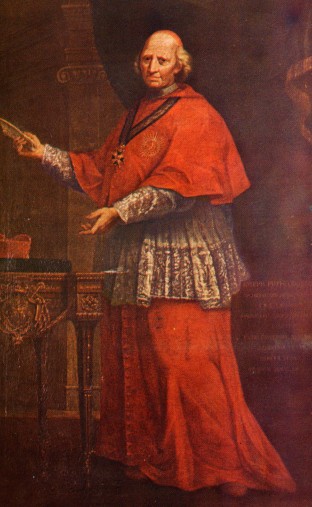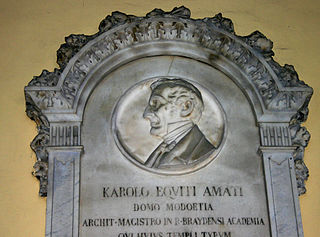San Carlo al Corso may refer to:
- San Carlo al Corso, Milan, church in Milan, Italy
- San Carlo al Corso, Noto, church in Noto, Italy
- Sant'Ambrogio e Carlo al Corso, church in Rome, Italy
San Carlo al Corso may refer to:

Noto is a city and comune in the Province of Syracuse, Sicily, Italy. It is 32 kilometres (20 mi) southwest of the city of Syracuse at the foot of the Iblean Mountains. It lends its name to the surrounding area Val di Noto. In 2002 Noto and its church were declared a UNESCO World Heritage Site.

Legnano is a town and comune (municipality) in the province of Milan, about 20 kilometres (12 mi) from central Milan. With 60,259, it is the thirteenth-most populous township in Lombardy. Legnano is located in the Alto Milanese and is crossed by the Olona River.

Sant'Ambrogio e Carlo al Corso is a basilica church in Rome, Italy, facing onto the central part of the Via del Corso. The apse of the church faces across the street, the Mausoleum of Augustus on Via di Ripetta.
San Carlo is the Italian for Saint Charles and may refer to:

San Carlo ai Catinari, also called Santi Biagio e Carlo ai Catinari, is an early-Baroque style church in Rome, Italy. It is located on Piazza Benedetto Cairoli, 117 just off the corner of Via Arenula and Via dei Falegnami, a few blocks south of the church of Sant'Andrea della Valle.

Giacinto Brandi was an Italian painter from the Baroque era, active mainly in Rome and Naples.

Charitable institutions attached to churches in Rome were founded right through the medieval period and included hospitals, hostels, and others providing assistance to pilgrims to Rome from a certain "nation", which thus became these nations' national churches in Rome. These institutions were generally organized as confraternities and funded through charity and legacies from rich benefactors belonging to that "nation". Often, they were also connected to national scholæ, where the clergymen of that nation were trained. The churches and their riches were a sign of the importance of their nation and of the prelates that supported them. Up to 1870 and Italian unification, these national churches also included churches of the Italian states.

The Diocese of Noto is a Latin Church diocese of the Catholic Church in Sicily, Italy. It is a suffragan diocese of the Archdiocese of Siracusa. Monsignor Antonio Staglianò is the current bishop of the diocese of Noto.

Alfonso Michele Litta was an Italian nobleman who was a Cardinal and Archbishop of Milan from 1652 to 1679.

Turin is a city and an important business and cultural centre in Northern Italy. It is the capital city of Piedmont and of the Metropolitan City of Turin, and was the first Italian capital from 1861 to 1865. The city is mainly on the western bank of the Po River, below its Susa Valley, and is surrounded by the western Alpine arch and Superga hill. The population of the city proper is 846,916, while the population of the urban area is estimated by Eurostat to be 1.7 million inhabitants. The Turin metropolitan area is estimated by the OECD to have a population of 2.2 million.

San Carlo al Corso is a neoclassic style, Roman Catholic church located in the Piazza of San Carlo, just off Corso Vittorio Emanuele II, just west of the Piazza San Babila, in central Mila, region of Lombardy, Italy.

Italian Neoclassical architecture refers to architecture in Italy during the Neoclassical period (1750s–1850s).

Giuseppe II Pozzobonelli was an Italian Cardinal and the Archbishop of Milan from 1743 to 1783.

Giovanni Antonio Emanueli was an Italian painter.

Carlo Amati was an Italian architect.

Neoclassical architecture in Milan encompasses the main artistic movement from about 1750 to 1850 in this northern Italian city. From the final years of the reign of Maria Theresa of Austria, through the Napoleonic Kingdom of Italy and the European Restoration, Milan was in the forefront of a strong cultural and economic renaissance in which Neoclassicism was the dominant style, creating in Milan some of the most influential works in this style in Italy and across Europe. Notable developments include construction of the Teatro alla Scala, the restyled Royal Palace, and the Brera institutions including the Academy of Fine Arts, the Braidense Library and the Brera Astronomical Observatory. Neoclassicism also led to the development of monumental city gates, new squares and boulevards, as well as public gardens and private mansions. Latterly, two churches, San Tomaso in Terramara and San Carlo al Corso, were completed in Neoclassical style before the period came to an end in the late 1830s.
Carlo Ascenzi was an Italian painter, active in a Baroque style.

The following outline is provided as an overview of and topical guide to Milan:
Libero Corso Bovio was an Italian lawyer, journalist and professor. He was the descendant of a family of Neapolitan lawyers and jurists, and he was also a lecturer in law and a journalist. He is also known for being the nephew of Italian poet and musician Libero Bovio and the great-grandson of the Italian philosopher Giovanni Bovio.

San Carlo al Corso is a Baroque-style, Roman Catholic church located on Corso Vittorio Emanuele #119 in the town of Noto, region of Sicily, Italy. This is also known as the Collegiata or collegiate church due to the adjacent Jesuit seminary and monastery.